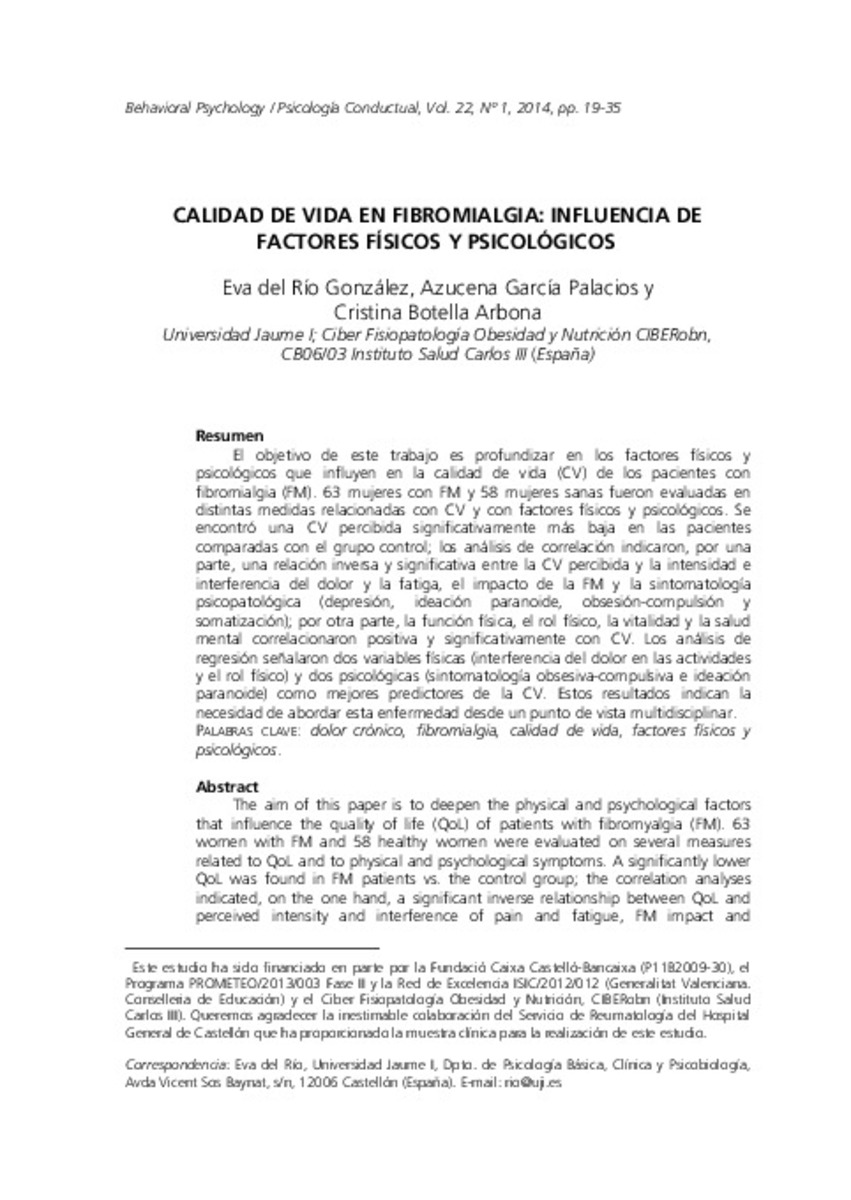Mostrar el registro sencillo del ítem
Calidad de vida en fibromialgia: Influencia de factores físicos y psicológicos
| dc.contributor.author | Río González, Eva del | |
| dc.contributor.author | Díaz-García, Amanda | |
| dc.contributor.author | Botella, Cristina | |
| dc.date.accessioned | 2015-05-13T11:24:58Z | |
| dc.date.available | 2015-05-13T11:24:58Z | |
| dc.date.issued | 2014 | |
| dc.identifier.issn | 1132-9483 | |
| dc.identifier.uri | http://hdl.handle.net/10234/120484 | |
| dc.description.abstract | El objetivo de este trabajo es profundizar en los factores físicos y psicológicos que influyen en la calidad de vida (CV) de los pacientes con fibromialgia (FM). 63 mujeres con FM y 58 mujeres sanas fueron evaluadas en distintas medidas relacionadas con CV y con factores físicos y psicológicos. Se encontró una CV percibida significativamente más baja en las pacientes comparadas con el grupo control; los análisis de correlación indicaron, por una parte, una relación inversa y significativa entre la CV percibida y la intensidad e interferencia del dolor y la fatiga, el impacto de la FM y la sintomatología psicopatológica (depresión, ideación paranoide, obsesión-compulsión y somatización); por otra parte, la función física, el rol físico, la vitalidad y la salud mental correlacionaron positiva y significativamente con CV. Los análisis de regresión señalaron dos variables físicas (interferencia del dolor en las actividades y el rol físico) y dos psicológicas (sintomatología obsesiva-compulsiva e ideación paranoide) como mejores predictores de la CV. Estos resultados indican la necesidad de abordar esta enfermedad desde un punto de vista multidisciplinar. | ca_CA |
| dc.description.abstract | The aim of this paper is to deepen the physical and psychological factors that influence the quality of life (QoL) of patients with fibromyalgia (FM). 63 women with FM and 58 healthy women were evaluated on several measures related to QoL and to physical and psychological symptoms. A significantly lower QoL was found in FM patients vs. the control group; the correlation analyses indicated, on the one hand, a significant inverse relationship between QoL and perceived intensity and interference of pain and fatigue, FM impact and psychopathological symptoms (depression, paranoid ideation, obsessive- compulsive and somatization); on the other hand, both physical function and physical role, vitality and mental health correlated positively and significantly with QoL. The regression analysis revealed that two physical variables (pain interference and physical role) and two psychological variables (obsessive- compulsive and paranoid ideation symptoms) presented the strongest relationship with QoL. These results indicate the need to address this syndrome from a multidisciplinary perspective. | ca_CA |
| dc.format.extent | 17 p. | ca_CA |
| dc.format.mimetype | application/pdf | ca_CA |
| dc.language.iso | spa | ca_CA |
| dc.publisher | Fundación VECA para el Avance de la Psicología Clínica Conductual | ca_CA |
| dc.relation.isPartOf | Psicología Conductual, 2014, Vol. 22, n. 1 | ca_CA |
| dc.rights.uri | http://rightsstatements.org/vocab/CNE/1.0/ | * |
| dc.subject | dolor crónico | ca_CA |
| dc.subject | fibromialgia | ca_CA |
| dc.subject | calidad de vida | ca_CA |
| dc.subject | factores físicos y psicológicos | ca_CA |
| dc.subject | chronic pain | ca_CA |
| dc.subject | fibromyalgia | ca_CA |
| dc.subject | quality of life | ca_CA |
| dc.subject | physical and psychological factors | ca_CA |
| dc.title | Calidad de vida en fibromialgia: Influencia de factores físicos y psicológicos | ca_CA |
| dc.type | info:eu-repo/semantics/article | ca_CA |
| dc.rights.accessRights | info:eu-repo/semantics/openAccess | ca_CA |
| dc.type.version | info:eu-repo/semantics/publishedVersion | ca_CA |
Ficheros en el ítem
Este ítem aparece en la(s) siguiente(s) colección(ones)
-
PSB_Articles [1301]
Articles de publicacions periòdiques







